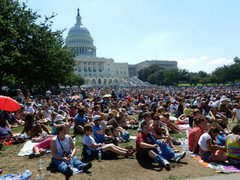How Your Book's Audience Should Shape Its Content
Biff Barnes
Who is your audience? How should that shape your writing?
Too many nonfiction writers think of neither of these questions as they draft their books. Their focus is strictly on what they want to say. The result may be that when their books are completed they fail to connect with readers.
 Courtesy of Wonderlane under Creative CommonsLet’s take a look at how thinking about a book's audience might influence the type of book a writer might create.
Courtesy of Wonderlane under Creative CommonsLet’s take a look at how thinking about a book's audience might influence the type of book a writer might create.
I recently spoke with a gentleman who has had a long career in international relations. He wants to create a book about ways in which foreign policy might be more effective. He’s got a wealth of knowledge and experience which give him some real insights into things that would produce better results than some of the programs we are currently employing. What should he do?
In considering his potential audience he must decide exactly whom he wants to write for:
If he addresses fellow policy wonks he can make some assumptions about his readers’ baseline knowledge. He can write in a more technical style with an emphasis on details and documentation that would be important to bureaucrats. However, his audience would be limited in size.
If he wants to reach a larger audience of general readers who might be interested in this area his book will need to be very different. He must begin by assuming that readers may be unfamiliar with all but the broadest outlines of policy. He’ll need to provide an overview of the field. Then he’ll need to establish why readers should care. This often means personalizing the issues. Using techniques of creative nonfiction he might give readers a first-hand look at the people who will feel the effects of the changes he proposes. This audience would require a book more focused on a conceptual approach and less on the minute details that would be important to technocrats.
Occasionally an author is able to bridge the gap between the technical and general audiences in a book that appeals to both. Eric Schlosser, did this very effectively in Fast Food Nation. Michael Lewis has hit a formula for this kind of book in Moneyball, The Big Short, and Boomerang.
A family historian faces a similar set of choices.
If she chooses to write only for a limited audience of family members and close friends readers will want to hear the colorful family stories.
But, if the author is a genealogist who wants to write a book fellow genealogists will use as a reference, she must emphasize the level of proof of the facts presented by providing detailed documentation, and sourcing.
A family historian hoping to sell her book to a general audience will need to put the family history into a broader historical context with details of the social history of the times, and an examination of the historical implications of the events described.
Taking time to consider both the desires and the needs of your intended audience before you begin your first draft (or as your revise, if you’ve already begun) will significantly increase your books chances for success.